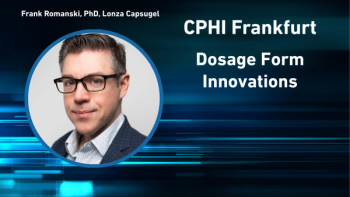
Advancing Softgel Technology for Poorly Soluble or Highly Potent APIs
The lipid-based method provides a tool for delivery of highly potent, poorly soluble, and unstable APIs. And new in-process capsule printing and shell technologies expand softgels’ applications further.
Softgel capsules are a drug-delivery form that offers pharmaceutical manufacturers a tool to overcome the growing formulating challenges presented by poorly soluble drugs and highly potent APIs. Advances in softgel technology are making it possible to use this drug-delivery approach for a wider selection of APIs, including those that must be processed at higher temperatures or wider pH ranges. New printing methods also reduce process time and make counterfeiting more difficult. Ted Andrew, Rx softgel product manager with Catalent Pharma Solutions, spoke with Cynthia Challener, editor of the Pharmaceutical Sciences, Manufacturing & Marketplace Report, about these developments and future applications of softgel technology.
Addressing bioavailability concernsPharmaceutical Sciences, Manufacturing and Marketplace Report: What are the key trends driving interest in softgel technology?
Andrew (Catalent): Bioavailability challenges associated with poorly soluble APIs (Biopharmaceutics Classification System (BCS) Class II and IV) are driving a lot of interest in lipid-based drug-delivery systems that are ideal for softgel formulations. As drug-discovery teams travel deeper into libraries and derivatives, the resulting, more complex leading candidates are typically less soluble and/or permeable than previously developed drugs. It is estimated that as many as 70% of new chemical entities are either poorly soluble, poorly permeable, or both.
Softgel technology offers a drug-delivery solution with the formulation flexibility to overcome these challenges. For example, lipid-based formulations can be used to overcome issues created by APIs that are practically insoluble in water and that spontaneously emulsify in gastric juices by keeping these APIs in solution for absorption and preventing precipitation. The technology offers good in-vivo performance with fast release of fill, has good development profiles, and is compatible with a wide range of excipients and formulations.
In addition, as clinical trials become more complicated and expensive, companies are increasingly looking for the optimal therapeutic profile; softgels can in many cases provide the fastest path and best chance for clinical success.
Expanded applicationsPharmaceutical Sciences, Manufacturing and Marketplace Report: When are softgels an appropriate delivery vehicle?
Andrew (Catalent): Softgels are the ideal delivery vehicle for an increasing number of applications. We have demonstrated that our softgels are particularly suited for very low dose APIs where content uniformity can be problematic (< 3 mg); potent compounds, hormones, and cytotoxic compounds where safe handling is required; poorly soluble or poorly permeable APIs; oxygen-labile APIs; APIs that are unstable in light or liquids; and in abuse- deterrent applications. In addition, we have developed a new technology that allows semisolid fills with a wider range of excipients, enhancers, and APIs, thus enabling more drug candidates to benefit from the therapeutic advantages of softgel technology.
New printing and ingredient technologiesPharmaceutical Sciences, Manufacturing and Marketplace Report: What are some recent advances in softgel capsule technology?
Andrew (Catalent): The two technologies that I think are worth noting are inline printing and the use of new materials in the shell that impart added performance properties.
For example, Catalent’s proprietary inline printing technology facilitates the printing of any required logo or graphic onto the softgel ribbon prior to encapsulation. The advantages of labelling prior to encapsulation include product differentiation through branding, process-time reduction, and reduced risk for counterfeiting because the label is in the same location on each and every capsule. The process also ensures a higher level of quality; mislabelled products may be outside of specification in some other way and can be quickly identified.
Meanwhile, softgel capsules manufactured using our [Catalent] new OptiShell technology containing starch and carrageenan in the shell, makes it possible to use a wider range of excipients, which in turn, expands the range of pH values and processing temperatures (up to 70 °C) that can be tolerated. As previously mentioned, these softgels can also be filled with semisolids.
Technology assessmentPharmaceutical Sciences, Manufacturing and Marketplace Report: What are the limitations of the technology?
Andrew (Catalent): A key limitation that we find is the perception that the softgel form is a “low” technology solution. Although there are tremendous advantages to formulating as a softgel, including a faster formulation time, improved stability, and a better therapeutic profile, the balance between the shell, excipients, and fill formulation is crucial for the long-term success of therapies. We are working to overcome this challenge by developing in-depth expertise in softgel formulation. In addition, with our in-house component library, it is possible to rapidly develop an optimal formulation and provide a smoother and quicker path to commercialization.
Another perceived limitation of the technology is that softgels are primarily an immediate-release technology. With recent advances in shell and fill formulations, such as shell technology with starch and carrageenan, it is now possible to provide a much wider range of therapeutic profiles, including extended- and modified-release.
Converting from intravenous to oral dosePharmaceutical Sciences, Manufacturing and Marketplace Report: Where do you see softgel capsule technology going in the future?
Andrew (Catalent): As the number of lead candidates that are difficult to formulate continues to grow and the costs of commercialization increase, softgel technology will continue to provide the industry with a faster, more effective path to market.
We expect that further advances will provide even more options to drug manufacturers that will help them overcome formulating challenges and bring their innovative products to market. One such example is the opportunity presented by the conversion of intravenous formulations to oral dose forms. Incorporating macromolecules into softgels may provide tremendous therapeutic and cost benefits to the marketplace.
Newsletter
Get the essential updates shaping the future of pharma manufacturing and compliance—subscribe today to Pharmaceutical Technology and never miss a breakthrough.




